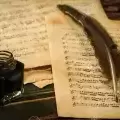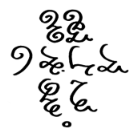Leaderboard
Popular Content
Showing content with the highest reputation on 10/31/2022 in all areas
-
Following a relatively long pause in my compositional schedule over the summer, I have once more set myself to work, and to my surprise, my contrapuntal skills haven't been as affected as I would have otherwise expected. Thus I have spent the Halloween eve composing this fugue, based on a previously abandoned yet still fairly recent subject. I would say I'm rather happy with how this one in particular turned out: four different pedal points, two stretti, and a number of episodes I haven't even bothered to count, perhaps fearing that I might come to unfoundedly disdain it as too repetitive. Who knows. Anyhow, here it is. Happy Halloween everyone! Halloween Fugue in G-sharp minor. - YouTube1 point
-
Good afternoon everyone! It's been a while since I've posted, so I thought I would come back with something fairly simple. A little while back I entered a small online composition contest. I was tasked with writing a 90 second piece of music to describe an image (pictured below). Sadly, I was not selected as a finalist... (hence the thread title lol) So I thought I would post my entry here for some feedback. There are two main themes I tried to develop, first in the trumpet at 0:04, and the second in the strings at 0:09. I only had 90 seconds, but I managed to make it into a quick ABA form. A couple of questions for feedback: What was your favorite part? Least favorite part? Do you feel the piece describes the image? Any critiques of technique, e.g. harmony, melody writing, counterpoint, orchestration, voice-leading, etc.? Do you have any comments of the quality of the performance in the audio file? I really want this to be a decent representation of how the piece would sound if it were performed live, since it is unlikely it ever will be. Feel free to put your "conductor hat" on and critique the "orchestra". Any critiques of the presentation of the score? Or the score video? Are there any composers this reminds you of, that I might enjoy listening to? Sound libraries: All winds and strings are VSL Synchron, all percussion is Spitfire Percussion. Score video: The image: Score: Competition Score - Transposed Score gmm.pdf1 point
-
1 point
-
1 point
-
Effective use of the relative minor! Those staccatissimo notes are very unidiomatic to play for the piano. Hammering away on the piano like that makes for a very harsh sound. At the very least the left hand should be considerably quieter than the melody (which you can do in musescore by ctrl-selecting the notes whose velocities you want to change and offset their velocities in the inspector by say 20 or 30 (on a scale of 0 - 127) below the melody). Also, your melodies are very often just arpeggiating the chord underneath. I was going to say that you could try to make more use of non-harmonic tones to write better melodies but you actually already have plenty of those in this piece. Maybe what's more striking about this piece is that it's one long run-on sentence. There aren't any cadences or pauses in the onslaught of ideas you're presenting the listener with. Usually when you speak to someone there are moments of respite before you begin another thought, right? Same thing should happen with music. Check out these wikipedia articles about different kinds of phrases you could try to build: Period (music) and Sentence (music). Thanks for sharing and I hope the above was at least somewhat helpful!1 point
-
I don't know why you used an Eb Horn in this piece. The piece is clearly in F and back in the classical period in music history, when horns didn't yet have valves it was customary for the horns to use crooks to be tuned to the same key that the piece is in. Most of the notes you've written for the horn in this piece are easily playable (i.e. part of the harmonic series in the key of F) by an F Horn but not on an Eb. In order to play the notes you have written the horn player (playing on an Eb crook) would have to stop the horn to for example, play the F#'s you have written in meas. 7 & 29. The written A's you have in the staff are also difficult to produce since the partial that naturally occurs in the Eb Horns harmonic series is a slightly flat Bb. But for F Horn that note would just be a G (both the high one and the low one) and could be played open with a clear tone. There are a few issues with the rest of the instruments as well. Sometimes I am hearing an oboe sound, but there's no oboes anywhere in your score. Also, you clearly meant for this to be played by a string orchestra, but the patches you're using are the individual violin, viola and cello patches (one instrument per part) which makes this sound like a string quartet with winds. Make sure you choose "Violins" instead of "Violin" when picking your instruments to get the full ensemble sound. Now about the music. It was customary in symphonies of this period to have at least 2 instruments play in pairs for the winds, to help sometimes fill out the harmony. I see you've written the main melody in the Violins and some harmonic heterogenous lines for the Flute. That's a good idea but it makes your orchestration sound really bare when the Flute and Horn don't have a partner to harmonize with in their own instrumental family. Harmonizing between different instrumental families isn't as effective nor full sounding because the timbres between the strings and winds are unique. Each part of the orchestra (strings, brass, woodwinds, percussion), in a sense, exists within it's own sound-world. I hope some of that was helpful! Thanks for sharing this symphony attempt and keep composing!1 point
-
What was your favorite part? Least favorite part? My favorite part was your mood change, at around 55 seconds in. The transition was so beautiful and elegant. My second favorite part was the beginning, I feel you draw the listener in right away. You do a really good job introducing your motif and making it stand prominent. Do you feel the piece describes the image? Yes indeed. Your crescendos, and trills are what help with the image I believe. Any critiques of technique, e.g. harmony, melody writing, counterpoint, orchestration, voice-leading, etc.? I feel melody (motif?) was just about right for this mood. You repeat it just enough times to let the listener know its the theme, and you break it up with your secondary theme at around 55 seconds in which is a good break for the listener. Orchestration seems fine to me, I'll have more to say about the quality of the recording. Do you have any comments of the quality of the performance in the audio file? I really want this to be a decent representation of how the piece would sound if it were performed live, since it is unlikely it ever will be. Feel free to put your "conductor hat" on and critique the "orchestra". The quality is really excellent. But as you know, us composers have a great ear for this stuff, and especially me because I am big on realism in recordings, and it is something I am advocating in my Music Jotter endeavor. The first thing is to make sure your instruments are a bit more balanced and sharp. The french horn is something I could hardly hear. I also want to hear woodwinds, they need to be "wetter" and much more pronounced. The treble has to be sharper and more audible in general. And the hardest part to get sounding realistic are the strings. I think the trick is making your instruments sharper, better balanced, wet sounding (this probably has to do with the quality of your reverb), and make sure your audio is at a -9db to -6db level. Take a listen to this recording for reference: https://www.youtube.com/watch?v=SVeaAhYluOc. Listen to the oboes here, they are VERY clear and beautiful. If you can emulate that a bit better in your recordings, you should win your next competition! 😉 Any critiques of the presentation of the score? Or the score video? I would upload the PDF in the post so people can take a closer look. Are there any composers this reminds you of, that I might enjoy listening to? Frederick Delius was quite good with imagery in my opinion, and this piece does remind me of his style. Overall Comments Overall, I love it! I think if you didn't win, perhaps the judges were looking for something else, or maybe they were a bit too elitist, who knows. But the piece is excellent in my opinion, and I am quite impressed with your ability to make your recordings sound more on the realistic side. I too, am a believer in making your recordings sound as realistic as possible.1 point
-
I think I commented on this work on your youtube channel. Many of the musical ideas are commendable and the counterpoint is OK. There are a couple areas that have hidden 5ths between the outer voices (see bar 7-8). The only other thing I should add is that rests are important in music. The only single rest that I can find is after the final cadence! This is particularly important for wind instrumentalists who would probably have a fit seeing this! Thanks for sharing.1 point
-
1 point

.thumb.png.8b5b433a341551e913a34392660bc95b.png)



